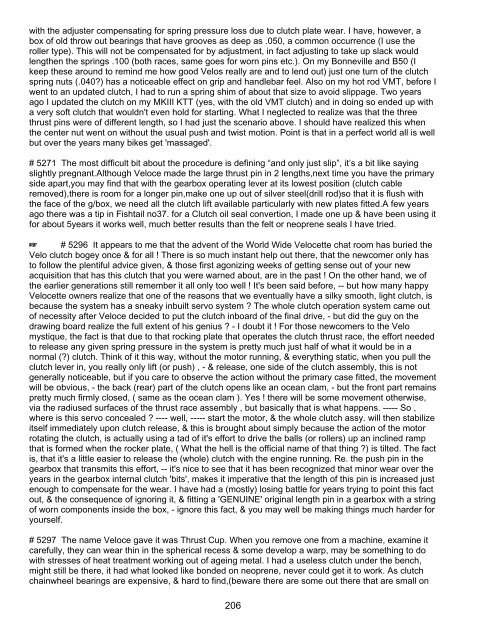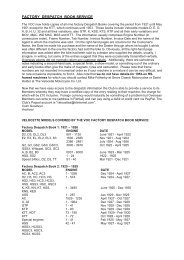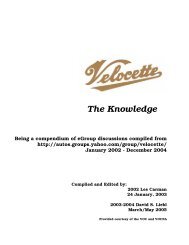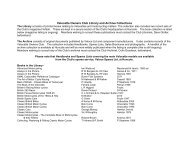The Knowledge - Velocette Owners Club
The Knowledge - Velocette Owners Club
The Knowledge - Velocette Owners Club
You also want an ePaper? Increase the reach of your titles
YUMPU automatically turns print PDFs into web optimized ePapers that Google loves.
with the adjuster compensating for spring pressure loss due to clutch plate wear. I have, however, a<br />
box of old throw out bearings that have grooves as deep as .050, a common occurrence (I use the<br />
roller type). This will not be compensated for by adjustment, in fact adjusting to take up slack would<br />
lengthen the springs .100 (both races, same goes for worn pins etc.). On my Bonneville and B50 (I<br />
keep these around to remind me how good Velos really are and to lend out) just one turn of the clutch<br />
spring nuts (.040?) has a noticeable effect on grip and handlebar feel. Also on my hot rod VMT, before I<br />
went to an updated clutch, I had to run a spring shim of about that size to avoid slippage. Two years<br />
ago I updated the clutch on my MKIII KTT (yes, with the old VMT clutch) and in doing so ended up with<br />
a very soft clutch that wouldn't even hold for starting. What I neglected to realize was that the three<br />
thrust pins were of different length, so I had just the scenario above. I should have realized this when<br />
the center nut went on without the usual push and twist motion. Point is that in a perfect world all is well<br />
but over the years many bikes get 'massaged'.<br />
# 5271 <strong>The</strong> most difficult bit about the procedure is defining “and only just slip”, it’s a bit like saying<br />
slightly pregnant.Although Veloce made the large thrust pin in 2 lengths,next time you have the primary<br />
side apart,you may find that with the gearbox operating lever at its lowest position (clutch cable<br />
removed),there is room for a longer pin,make one up out of silver steel(drill rod)so that it is flush with<br />
the face of the g/box, we need all the clutch lift available particularly with new plates fitted.A few years<br />
ago there was a tip in Fishtail no37. for a Clutch oil seal convertion, I made one up & have been using it<br />
for about 5years it works well, much better results than the felt or neoprene seals I have tried.<br />
L # 5296 It appears to me that the advent of the World Wide <strong>Velocette</strong> chat room has buried the<br />
Velo clutch bogey once & for all ! <strong>The</strong>re is so much instant help out there, that the newcomer only has<br />
to follow the plentiful advice given, & those first agonizing weeks of getting sense out of your new<br />
acquisition that has this clutch that you were warned about, are in the past ! On the other hand, we of<br />
the earlier generations still remember it all only too well ! It's been said before, -- but how many happy<br />
<strong>Velocette</strong> owners realize that one of the reasons that we eventually have a silky smooth, light clutch, is<br />
because the system has a sneaky inbuilt servo system ? <strong>The</strong> whole clutch operation system came out<br />
of necessity after Veloce decided to put the clutch inboard of the final drive, - but did the guy on the<br />
drawing board realize the full extent of his genius ? - I doubt it ! For those newcomers to the Velo<br />
mystique, the fact is that due to that rocking plate that operates the clutch thrust race, the effort needed<br />
to release any given spring pressure in the system is pretty much just half of what it would be in a<br />
normal (?) clutch. Think of it this way, without the motor running, & everything static, when you pull the<br />
clutch lever in, you really only lift (or push) , - & release, one side of the clutch assembly, this is not<br />
generally noticeable, but if you care to observe the action without the primary case fitted, the movement<br />
will be obvious, - the back (rear) part of the clutch opens like an ocean clam, - but the front part remains<br />
pretty much firmly closed, ( same as the ocean clam ). Yes ! there will be some movement otherwise,<br />
via the radiused surfaces of the thrust race assembly , but basically that is what happens. ----- So ,<br />
where is this servo concealed ? ---- well, ----- start the motor, & the whole clutch assy. will then stabilize<br />
itself immediately upon clutch release, & this is brought about simply because the action of the motor<br />
rotating the clutch, is actually using a tad of it's effort to drive the balls (or rollers) up an inclined ramp<br />
that is formed when the rocker plate, ( What the hell is the official name of that thing ?) is tilted. <strong>The</strong> fact<br />
is, that it's a little easier to release the (whole) clutch with the engine running. Re. the push pin in the<br />
gearbox that transmits this effort, -- it's nice to see that it has been recognized that minor wear over the<br />
years in the gearbox internal clutch 'bits', makes it imperative that the length of this pin is increased just<br />
enough to compensate for the wear. I have had a (mostly) losing battle for years trying to point this fact<br />
out, & the consequence of ignoring it, & fitting a 'GENUINE' original length pin in a gearbox with a string<br />
of worn components inside the box, - ignore this fact, & you may well be making things much harder for<br />
yourself.<br />
# 5297 <strong>The</strong> name Veloce gave it was Thrust Cup. When you remove one from a machine, examine it<br />
carefully, they can wear thin in the spherical recess & some develop a warp, may be something to do<br />
with stresses of heat treatment working out of ageing metal. I had a useless clutch under the bench,<br />
might still be there, it had what looked like bonded on neoprene, never could get it to work. As clutch<br />
chainwheel bearings are expensive, & hard to find,(beware there are some out there that are small on<br />
206





